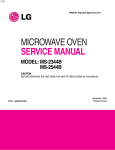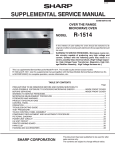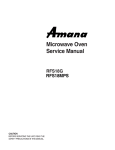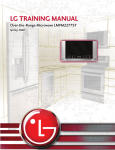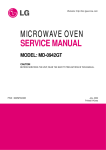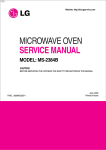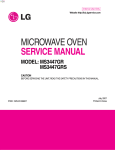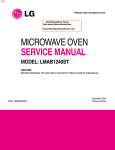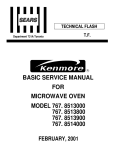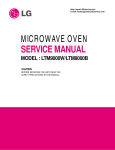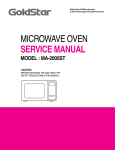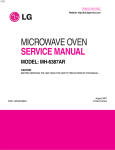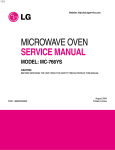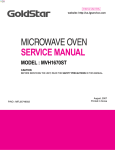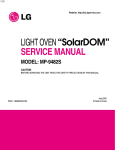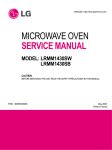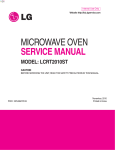Download MICROWAVE OVEN SERVICE MANUAL
Transcript
MICROWAVE OVEN SERVICE MANUAL MODEL : MB-319ML MB-319MLA CAUTION BEFORE SERVICING THE UNIT, READ THE SAFETY PRECAUTIONS IN THIS MANUAL. SAFETY PRECAUTIONS This device is to be serviced only by properly qualified service personnel. Consult the service manual for proper service procedures to assure continued safety operation and for precautions to be taken to avoid possible exposure to excessive microwave energy. PRECAUTIONS TO BE OBSERVED BEFORE AND DURING SERVICING TO AVOID POSSIBLE EXPOSURE TO EXCESSIVE MICROWAVE ENERGY A) Do not operate or allow the oven to be operated with the door open. B) Make the following safety checks on all ovens to be serviced before activating the magnetron or other microwave source, and make repairs as necessary; (1) interlock operation, (2) proper door closing, (3) seal and sealing surfaces (arcing, wear, and other damage), (4) damage to or loosening of hinges and latches, (5) evidence of dropping or abuse. C) Before turning on microwave power for any service test or inspection within the microwave generating compartments, check the magnetron, wave guide or transmission line, and cavity for proper alignment, integrity, and connections. D) Any defective or misadjusted components in the interlock, monitor, door seal, and microwave generation and transmission systems shall be repaired, replaced, or adjusted by procedures described in this manual before the oven is released to the owner. CONTENTS (Page) SAFETY PRECAUTIONS - - - - - - - - - - - - - - - - - - - - - - - - - - - - - - - - - - - - - - - - - - - - - - - - - - - - - - - - - - - - - - - - - - - - - Inside front cover SPECIFICATIONS - - - - - - - - - - - - - - - - - - - - - - - - - - - - - - - - - - - - - - - - - - - - - - - - - - - - - - - - - - - - - - - - - - - - - - - - - - - - - - - - - - - - - - - - - - - - - - - - - - - - - 1-1 CAUTIONS - - - - - - - - - - - - - - - - - - - - - - - - - - - - - - - - - - - - - - - - - - - - - - - - - - - - - - - - - - - - - - - - - - - - - - - - - - - - - - - - - - - - - - - - - - - - - - - - - - - - - - - - - - - - - - 2-1 INSTALLATIONS - - - - - - - - - - - - - - - - - - - - - - - - - - - - - - - - - - - - - - - - - - - - - - - - - - - - - - - - - - - - - - - - - - - - - - - - - - - - - - - - - - - - - - - - - - - - - - - - - - - - - - 3-1 OPERATING INSTRUCTIONS - - - - - - - - - - - - - - - - - - - - - - - - - - - - - - - - - - - - - - - - - - - - - - - - - - - - - - - - - - - - - - - - - - - - - - - - - - - - - - - - - - - - 4-1 FEATURES- - - - - - - - - - - - - - - - - - - - - - - - - - - - - - - - - - - - - - - - - - - - - - - - - - - - - - - - - - - - - - - - - - - - - - - - - - - - - - - - - - - - - - - - - - - - - - - - - - - - - - - - - - - - - - - - - - - - - - - - 4-1 CONTROL PANEL - - - - - - - - - - - - - - - - - - - - - - - - - - - - - - - - - - - - - - - - - - - - - - - - - - - - - - - - - - - - - - - - - - - - - - - - - - - - - - - - - - - - - - - - - - - - - - - - - - - - - - - - - - - - - 4-1 OPERATING SEQUENCE- - - - - - - - - - - - - - - - - - - - - - - - - - - - - - - - - - - - - - - - - - - - - - - - - - - - - - - - - - - - - - - - - - - - - - - - - - - - - - - - - - - - - - - - - - - - - - - - - - - - 4-2 SCHEMATIC DIAGRAM - - - - - - - - - - - - - - - - - - - - - - - - - - - - - - - - - - - - - - - - - - - - - - - - - - - - - - - - - - - - - - - - - - - - - - - - - - - - - - - - - - - - - - - - - - - - - - - - - - - - - - 4-3 CIRCUIT DESCRIPTION - - - - - - - - - - - - - - - - - - - - - - - - - - - - - - - - - - - - - - - - - - - - - - - - - - - - - - - - - - - - - - - - - - - - - - - - - - - - - - - - - - - - - - - - - - - - - - - - - - - - - 4-4 SERVICE INFORMATION - - - - - - - - - - - - - - - - - - - - - - - - - - - - - - - - - - - - - - - - - - - - - - - - - - - - - - - - - - - - - - - - - - - - - - - - - - - - - - - - - - - - - - - - - - 5-1 TOOLS AND MEASURING INSTRUMENTS - - - - - - - - - - - - - - - - - - - - - - - - - - - - - - - - - - - - - - - - - - - - - - - - - - - - - - - - - - - - - - - - - - - - - - - - - - - 5-1 MICROWAVE LEAKAGE TEST - - - - - - - - - - - - - - - - - - - - - - - - - - - - - - - - - - - - - - - - - - - - - - - - - - - - - - - - - - - - - - - - - - - - - - - - - - - - - - - - - - - - - - - - - - - - 5-1 MEASUREMENT OF MICROWAVE POWER OUTPUT - - - - - - - - - - - - - - - - - - - - - - - - - - - - - - - - - - - - - - - - - - - - - - - - - - - - - - - - - - - 5-3 DISASSEMBLY AND ADJUSTMENT - - - - - - - - - - - - - - - - - - - - - - - - - - - - - - - - - - - - - - - - - - - - - - - - - - - - - - - - - - - - - - - - - - - - - - - - - - - - - - - - - - - - - 5-3 INTERLOCK CONTINUITY TEST- - - - - - - - - - - - - - - - - - - - - - - - - - - - - - - - - - - - - - - - - - - - - - - - - - - - - - - - - - - - - - - - - - - - - - - - - - - - - - - - - - - - - - - - - - 5-7 COMPONENT TEST PROCEDURE - - - - - - - - - - - - - - - - - - - - - - - - - - - - - - - - - - - - - - - - - - - - - - - - - - - - - - - - - - - - - - - - - - - - - - - - - - - - - - - - - - - - - - 5-8 TROUBLE SHOOTING - - - - - - - - - - - - - - - - - - - - - - - - - - - - - - - - - - - - - - - - - - - - - - - - - - - - - - - - - - - - - - - - - - - - - - - - - - - - - - - - - - - - - - - - - - - - - - - - - - - - - - 5-12 EXPLODED VIEW - - - - - - - - - - - - - - - - - - - - - - - - - - - - - - - - - - - - - - - - - - - - - - - - - - - - - - - - - - - - - - - - - - - - - - - - - - - - - - - - - - - - - - - - - - - - - - - - - - - - - 6-1 REPLACEMENT PARTS LIST - - - - - - - - - - - - - - - - - - - - - - - - - - - - - - - - - - - - - - - - - - - - - - - - - - - - - - - - - - - - - - - - - - - - - - - - - - - - - - - - - - - - 7-1 SCHEMATIC DIAGRAM OF P.C.B. - - - - - - - - - - - - - - - - - - - - - - - - - - - - - - - - - - - - - - - - - - - - - - - - - - - - - - - - - - - - - - - - - - - - - - - - - - - - - - 8-1 PRINTED CIRCUIT BOARD - - - - - - - - - - - - - - - - - - - - - - - - - - - - - - - - - - - - - - - - - - - - - - - - - - - - - - - - - - - - - - - - - - - - - - - - - - - - - - - - - - - - - - - - - - - - - - - - - 8-2 P.C.B. PARTS LIST - - - - - - - - - - - - - - - - - - - - - - - - - - - - - - - - - - - - - - - - - - - - - - - - - - - - - - - - - - - - - - - - - - - - - - - - - - - - - - - - - - - - - - - - - - - - - - - - - - - 9-1 SPECIFICATIONS DESCRIPTION ITEM MB-319ML MB-319MLA 120 Volts AC 60 Hz 220 Volts AC 60 Hz MODEL Power Requirement MICROWAVE 1,400 Watts (12.0) GRILL 1,050 Watts Single phase, 2-wire grounded Power Output 1,000 Watts full microwave power (IEC60705) Microwave Frequency 2,450 MHz Magnetron 2M246 Timer 0 ~ 99 min. 99 sec. Outside Dimensions 530 (W) x 315 (H) x 394 (D) Cavity Dimensions 350 (W) x 240 (H) x 365 (D) Net Weight 16.3 kg (approx.) Shipping weight 18.7 kg (approx.) Control Complement Touch Control System Clock : 1:00 - 12:59 Microwave Power for Variable Cooking Power level HIGH ----------------------------------------Full power throughout the cooking time 9 (Saute) -------------------------approx. 90% of Full power, 8 (Reheat) --------approx. 80% 7 (Med.-High) --------------------approx. 70%, 6 (Medium) --------approx. 60% 5 (Med.-Low) --------------------approx. 50%, 4 (Defrost) ---------approx. 40% 3 (Low) ---------------------------approx. 30%, 2 (Simmer)--------approx. 20% 1 (Warm)--------------------------approx. 10% Nameplate Location Back Side Owner's manual & Cooking guide Accessories Glass turntable Rotating ring Grill Rack This microwave oven is designed for household use only. It is not recommended for commercial purposes. 1-1 CAUTIONS Unlike other appliances, the microwave oven is high-voltage and high-current equipment. Though it is free from danger in ordinary use, extreme care should be taken during repair. MICROWAVE RADIATION Personnel should not be exposed to the microwave energy which may radiate from the magnetron or other microwave generating device if it is improperly used or connection. All input and output microwave connections, waveguide, flange, and gasket must be secure never operate the device without a microwave energy absorbing load attached. Never look into an open waveguide or antenna while the device is energized. • DO NOT operate on a 2-wire extension cord during repair and use. • NEVER TOUCH any oven components or wiring during operation. • BEFORE TOUCHING any parts of the oven, always remove the power plug from the outlet. • For about 30 seconds after the oven stops, an electric charge remains in the high voltage capacitor. When replacing or checking, you must discharge the high voltage capacitor by shorting across the two terminals with an insulated screwdriver. • Proper operation of the microwave oven requires that the magnetron be assembled to the waveguide and cavity. Never operate the magnetron unless it is properly installed. • Be sure that the magnetron gasket is properly installed around the dome of the tube whenever installing the magnetron. ANTENNA Gasket COOLING FIN FILAMENT TERMINALS MAGNETRON CHASSIS GROUND MAGNETRON • Remove your watches whenever working close to or replacing the Magnetron. • DO NOT touch any parts of the control panel circuit. A resulting static electric discharge may damage this P.C.B. • NEVER operate the oven with no load. • NEVER injure the door seal and front plate of the oven cavity. • NEVER put iron tools on the magnetron. • NEVER put anything into the latch hole and the interlock switches area. THE OVEN IS TO BE SERVICED ONLY BY PROPERLY QUALIFIED SERVICE PERSONNEL. 2-1 INSTALLATIONS BEFORE YOU BEGIN, READ THE FOLLOWING INSTRUCTIONS COMPLETELY AND CAREFULLY. INSTALLING EARTHING INSTRUCTIONS 1. Empty the microwave oven and clean inside it with a soft, damp cloth. Check for damage such as misaligned door, damage around the door or dents inside the cavity or on the exterior. This microwave oven is designed to be used in a fully earthed condition. It is imperative, therefore, to make sure it is properly earthed before servicing 2. Put the oven on a counter, table, or shelf that is strong enough to hold the oven and the food and utensils you put in it. (The control panel side of the oven is the heavy side. Use care when handling.) WARNINGTHIS APPLIANCE MUST BE EARTHED 3. Do not block the vent and the air intake openings. Blocking vent or air intake openings can cause damage to the oven and poor cooking results. Make sure the microwave oven legs are in place to ensure proper air flow. 4. The oven should not be installed in any area where heat and steam are generated, because they may damage the electronic or mechanical parts of the unit. Do not install the oven next to a conventional surface unit or above a conventional wall oven. 5. Use microwave oven in an ambient temperature less than 104°F(40°C). 6. Place the microwave oven on a sturdy and flat surface at least 10 cm(4 inches) from the wall. 7. Place the microwave oven as far away as possible from TV, RADIO, COMPUTER, etc., to prevent interference. 10cm 3-1 OPERATING INSTRUCTIONS FEATURES Oven Front Plate Window Door Screen Door Seal Display Window Control Panel Door Open Button Safety Door Lock System Turntable Rotating Ring Grill Rack Metal Tray Turntable Shaft CONTROL PANEL 1. BRAZILLIAN COOK : This menu has been pre programmed to cook food automatically by one touch. 2. MENUS LIGHT: To let your microwave cook your selections. 11 2 3 3. OPTION: You can select on/off of beeper, scroll speed control and on/off of Demo. 4. AUTO COOK: This oven’s menu has been preprogrammed to automatically to cook food. 1 5. AUTO REHEAT: This oven’s menu has been to preprogrammed to automatically reheat food. 4 6. AUTO DEFROST: To select the desired auto weight defrost programmed with dial. 5 7. AUTO CRISP 6 7 9 8. STOP/CLEAR: To stop oven and clear all entries except time of day 8 9. MANUAL. 10 10. START: This feature allows oven to begin functioning. 11. DISPLAY WINDOW: Provides indications of the functions selected, normally current time displayed. 4-1 OPERATING SEQUENCE 7. AUTO WEIGHT DEFROST COOKING The following is a description of component functions during oven operation. Desliga/Cancela 2X Auto Descongela 1. SETTING THE CLOCK Dial (Number) Liga 8. CHILD LOCK Desliga/Cancela Manual Liga Dial Liga Dial This oven has a CHILD LOCK feature TO SET CHILD LOCK • Touch the Desliga/Cancela button • Touch and hold Desliga/Cancela button DESATIVADO appear on the display. Liga Dial NOTE: 1) This is a 24 hour clock. 2) Clock will operate as long as power is applied to the oven. TO CANCEL CHILD LOCK • Touch the Desliga/Cancela button • Touch and hold Desliga/Cancela button ATIVADO appears. 2. CANCEL FUNCTION Touch the Desliga/Cancela pad whenever you need to cancel an entry or a function currently in use. The display will either return to the last item entered or to the clock. 9. CUSTOM SET You can select ON/OFF of beeper, language speed, DEMO mode. 3. QUICK START • To select sound ON/OFF Desliga/Cancela Liga Desliga/Cancela 4. ONE TOUCH COOKING Desliga/Cancela Opções Liga • To select language speed. Pratos Brosileiros Dial Desliga/Cancela Liga Opções Liga Liga 5. TIME COOKING Desliga/Cancela Manual Dial(Power) • To select DEMO mode. Liga Desliga/Cancela Dial(Time) Liga 6. MULTI-STAGE COOKING 1ST STAGE Desliga/Cancela Dial Liga Dial(Time) Liga 2ND STAGE Manual Dial(Time) Dial(Power) Liga Liga 4-2 Opções Liga Dial SCHEMATIC DIAGRAM 4-3 CIRCUIT DESCRIPTION • A high voltage of approximately 2100 volts AC is generated in the secondary of the high voltage transformer which is increased by the action of the high voltage diode and charging of the high voltage capacitor. • The negative 4,000 Volts DC is applied to the filament of the magnetron. GENERAL DETAILS • The low voltage transformer supplies the necessary voltage to the micom controller when power cord is plugged in. • When the door is closed, the primary switch is ON, the secondary switch is ON, and the monitor switch opens (contact COM and NO). WHEN THE OVEN IS SET AT ANY LEVEL EXCEPT MAXIMUM. WHEN SELECTING COOKING POWER LEVEL AND TIME • The micom controller controls the ON-OFF time of relay 2 by the applied signal to vary the average output power of microwave oven as POWER LEVEL. (refer to page 1-1) • One complete cycle of the relay 2 is 22 seconds. • The micom controller memorizes the function you set. • The time you set appears in the display window. • Each indicator light turns on to indicate that the stage has been set. WHEN THE DOOR IS OPENED DURING COOKING WHEN TOUCHING THE START PAD • The coil of the relay is energized by the micom controller. • Power input is supplied to the high voltage transformer through the fuse to the primary switch and relay 2. • Turntable rotates. FUSE • Both the primary switch and relay 2 cut off the primary winding voltage of the high voltage transformer. • ON-OFF of relay 2 is coupled electrically with opening and closing of the secondary switch. • When the door is opened, the secondary switch is opened and when the door is closed, the secondary switch is closed. • The cooking time stops counting down. • Relay stops functioning. • As the door is opened, if the contact of primary switch and relay 2 and/or secondary switch fail to open, the fuse opens due to the large current surge caused by the monitor switch activation, which, in turn, stops magnetron oscillation. PRIMARY SWITCH L MONITOR SWITCH N RELAY 2 H.V. TRANSFORMER SECONDARY SWITCH FUSE PRIMARY SWITCH L MICOM CONTROLLER H.V. TRANSFORMER MONITOR SWITCH • The fan motor rotates and cools the magnetron by blowing air (coming from the intake on the base-plate). • The air is also directed into the oven to exhaust the vapor in the oven through the upper plate. • Cooking time starts counting down. • 3.3 volts AC is generated from the filament winding of the high voltage transformer. This 3.3 volts is applied to the magnetron to heat the magnetron filament through two noise-preventing choke coils. N RELAY 2 SECONDARY SWITCH MICOM CONTROLLER 4-4 SERVICE INFORMATION TOOLS AND MEASURING INSTRUMENTS NECESSARY TOOLS NECESSARY MEASURING INSTRUMENTS Tools normally used for TV servicing are sufficient. Standard tools are listed below. • Diagonal pliers • Long nose pliers • Phillips screwdriver • Flat blade screwdriver • Wrench (size 5mm) • Nutdriver (size 5mm) • Adjustable wrench • Soldering iron • Solder • Vinyl insulation tape • Polishing cloth • TESTER (VOLTS-DC, AC, Ohmmeter) • Microwave survey meter - Holaday HI-1500 HI-1501 - Narda 8100 8200 • Inch scale • 600 cc non conductive material beaker (glass or plastic), inside diameter: approx. 8.5 cm (31/2 in.) • Cylindrical and made of borosilicate glass vessel. max. thickness: 3 mm outside diameter: approx. 190mm height: approx. 90mm • Glass thermometer: 100°C or 212°F (1 deg scale) MICROWAVE LEAKAGE TEST CAUTIONS MEASURING MICROWAVE ENERGY LEAKAGE • Be sure to check microwave leakage prior to servicing the oven if the oven is operative prior to servicing. • The service personnel should inform the manufacture importer, or assembler of any certified oven unit found to have a microwave emission level in excess of 5 mW/cm2 and should repair any unit found to have excessive emission levels at no cost to the owner and should ascertain the cause of the excessive leakage. The service personnel should instruct the owner not to use the unit until the oven has been brought into compliance. • If the oven operates with the door open, the service personnel should: - Tell the user not to operate the oven. - Contact the manufacturer. • The service personnel should check all surface and vent openings for microwave leakage. • Check for microwave leakage after every servicing. The power density of the microwave radiation leakage emitted by the microwave oven should not exceed 4 mW/cm2. Always start measuring of an unknown field to assure safety for operating personnel from radiation leakage. • Pour 275±15cc of 20±5°C (68±9°F) water in a beaker which is graduated to 600 cc, and place the beaker on the center of the turntable. • Set the energy leakage monitor to 2,450 MHz and use it following the manufacturer's recommended test procedure to assure correct result. • When measuring the leakage, always use the 2-inch (5cm) spacer supplied with the probe. • Operate the oven at its maximum output. • Measure the microwave radiation using and electromagnetic radiation monitor by holding the probe perpendicular to the surface being measured Move probe along shaded area Probe scanning speed Less than 2.5 cm/sec (1 in/sec) 5-1 MEASUREMENT WITH OUTER CASE REMOVED NOTES WHEN MEASURING • Do not exceed meter full scale deflection. • The test probe must be removed no faster than 1 inch/sec (2.5 cm/sec) along the shaded area, otherwise a false reading may result. • The test probe must be held with the grip portion of the handle. A false reading may result if the operator's hand is between the handle and the probe. • When testing near a corner of the door, keep the probe perpendicular to the surface making sure the probe horizontally along the oven surface; this may cause probe damage. • When you replace the magnetron, measure for microwave energy leakage before the outer case is installed and after all necessary components are replaced or adjusted. Special care should be taken in measuring the following parts. (Circled area of Fig. below) - Around the magnetron - The waveguide WARNING : AVOID CONTACTING ANY HIGH VOLTAGE PARTS RECORD KEEPING AND NOTIFICATION AFTER MEASUREMENT • After adjustment and repair of any microwave energy interruption or microwave energy blocking device, record the measured values for future reference. Also enter the information on the service invoice. • The microwave energy leakage should not be more than 4 mW/cm.sq. after determining that all parts are in good condition, functioning properly and genuine replacement parts which are listed in this manual have been used. • At least once a year, have the electromagnetic energy leakage monitor checked for calibration by its manufacturer. MEASUREMENT WITH A FULLY ASSEMBLED OVEN • After all components, including the outer case, are fully assembled, measure for microwave energy leakage around the door viewing window, the exhaust opening, and air inlet openings. • Microwave energy leakage must not exceed the values prescribed below. NOTE: Leakage with the outer case removed less than 5 mW/cm.sq. Leakage for a fully assembled oven (Before the latch switch (primary) is interrupted) with the door in a slightly opened position-less than 2 mW/cm.sq. 5-2 MEASUREMENT OF MICROWAVE POWER OUTPUT • Microwave power output measurement is made with the microwave oven supplied at its rated voltage and operated at its maximum microwave power setting with a load of (1000±5) g of potable water. • The water is contained in a cylindrical borosilicate glass vessel having a maximum material thickness of 3 mm and an outside diameter of approximately 190mm. • The oven and the empty vessel are at ambient temperature prior to the start of the test. • The initial temperature (T1) of the water is (10±2)°C It is measured immediately before the water is added to the vessel. After addition of the water to the vessel, the load is immediately placed on the center of the turntable which is in the lowest position and the microwave power switched on. • The time T for the temperature of the water to rise by a value ∆ T of (10±2)° is measured, where T is the time in seconds and ∆T is the temperature rise. The initial and final water temperatures are selected so that the maximum difference between the final water temperature and the ambient temperature is 5°. • The microwave power output P in watts is calculated from the following formula : P= 4187 x (∆T) T is measured while the microwave generator is operating at full power. Magnetron filament heat-up time is not included. (about 3 sec) • The water is stirred to equalize temperature throughout the vessel, prior to measuring the final water temperature. • Stirring devices and measuring instruments are selected in order to minimize addition or removal of heat. WATER LOAD TURNTABLE DISASSEMBLY AND ADJUSTMENT A. OUTER CASE REMOVAL Remove the screw securing screw 1) Disconnect the power supply cord from the outlet. 2) Remove the screws from the rear of the case. The outer case must be moved backward to be lifted off. B. POWER SUPPLY CORD 1) Remove the outer case. 2) Disconnect two terminals and remove one screw of the ground terminal. ground screw C. CONTROL PANEL ASSEMBLY 1) Open the door. 2) Disconnect the leadwire from RELAY (RY2) of the PCB SUB ASSEMBLY. 3) Disconnect the leadwire from connector (CN1) of the PCB SUB ASSEMBLY. 4) Lift up and pull out control panel assembly carefully from the cavity. Lift up and pull out control panel CAUTION: DISCHARGE THE HIGH VOLTAGE CAPACITOR BEFORE SERVICING (refer to page 2-1) 5-3 D. PCB ASSEMBLY REMOVAL Remove choke cover 1) Remove the control panel assembly from the cavity. (Refer to control panel assembly removal on previous page.) 2) Remove screws which hold the PCB SUB ASSEMBLY to the control panel. 3) Disconnect the flat cable from the PCB SUB ASSEMBLY and take off the PCB SUB ASSEMBLY. PCB Sub Asm Control Panel Remove door Door seal plate E. DOOR MAIN ASSEMBLY REMOVAL 1) Open the door. 2) Remove the choke cover very carefully with a flat-blade screwdriver. CAUTION: Be careful not to damage door seal plate by screwdriver. 3) Lift up and push the door. NOTE: 1. After replacing the door, be sure to check that the primary switch, monitor switch, and secondary switch operate normally. 2. After replacing the door, check for microwave energy leakage with a survey meter. Microwave energy must be below the limit of 4 mW/cm. (with a 275 ml water load) 3. When mounting the door assembly to the oven assembly, be sure to adjust the door assembly parallel to the chassis. Also, adjust so the door has no play between the inner door surface and oven frame assembly. If the door assembly is not mounted properly, microwaves may leak from the clearance between the door and the oven. Spacer 5-4 F. MAGNETRON REMOVAL G. REMOVING THE TURNTABLE MOTOR 1) Remove the turntable and rotating ring. 2) Lay the unit down on its back. 3) Remove the turntable motor cover. The turntable base cover is easily removed by pinching the eight parts with a wire cutting. 4) Disconnect the leadwire from the turntable motor terminals. 5) Remove the screw securing the turntable motor to the oven cavity ASSEMBLY. 6) After repairing the motor, rotate the removed turntable motor cover. 7) Fit the turntable motor cover’s projecting part to the base plate slit. 1) Disconnect the leadwire from the magnetron. 2) Carefully remove the mounting screws holding the magnetron and the waveguide. 3) Remove the magnetron ASSEMBLY until the tube is clear from the waveguide. NOTE: 1. When removing the magnetron, make sure its dome does not hit any adjacent parts, or it may be damaged. 2. When replacing the magnetron, be sure to install the magnetron gasket in the correct position and be sure that the gasket is in good condition. 3. After replacing the magnetron, check for microwave leakage with a survey meter around the magnetron. Microwave energy must be below the limit of 5 mW/cm2. (With a 275 ml. water load). Make sure that gasket is rigidly attached to the magnetron. To prevent microwave leakage, tighten the mounting screws properly, making sure there is no gap between the waveguide and the magnetron. NOTE: 1. Remove the wire lead from the turntable motor VERY CAREFULLY. 2. Be sure to grasp the connector, not the wires, when removing. Air Duct Magnetron Waveguide Dome Waveguide Bracket Magnetron Gasket Magnetron Turntable Motor 5-5 Wire Leads H. HIGH VOLTAGE TRANSFORMER REMOVAL K. INTERLOCK SYSTEM 1) INTERLOCK MECHANISM The door lock mechanism is a device which has been specially designed to eliminate completely microwave activity when the door is opened during cooking and thus to prevent the danger resulting from the microwave leakage. 1) Discharge the high voltage capacitor. 2) Disconnect the leadwire from magnetron, high voltage transformer, and capacitor. 3) Remove the screw holding the high voltage transformer to the baseplate. 2) MOUNTING OF THE PRIMARY/MONITOR/ SECONDARY SWITCHES TO THE LATCH BOARD 3) INSTALLATION AND ADJUSTMENT OF THE LATCH BOARD TO THE OVEN ASSEMBLY • Mount the latch board to the oven assembly. • Adjust the latch board in the arrow direction so that oven door will not have any play in it when the door is closed. • Tighten the mounting screw. • Check for play in the door by pushing the door release button. Door movement should be less than 0.5 mm. (1/64 inch) Don't push the door release button while making this adjustment. Make sure that the latch moves smoothly after adjustment is completed and that the screws are tight. Make sure the primary, monitor, and secondary switches operate properly by following the continuity test procedure. I. FAN MOTOR ASSEMBLY REMOVAL 1) Discharge the high voltage capacitor. 2) Disconnect the leadwire from fan motor and high voltage capacitor. 3) Remove the two screws holding the the suction guide ASSEMBLY to the oven cavity. 4) Remove the two screws holding the fan motor ASSEMBLY to the suction guide ASSEMBLY. J. HIGH VOLTAGE CAPACITOR AND DIODE REMOVAL 1) Discharge the high voltage capacitor. 2) Disconnect the leadwire from fan motor and high voltage capacitor. 3) Remove the screw holding the suction guide ASSEMBLY to the oven cavity. 4) Remove the screw holding the high voltage capacitor bracket and remove the high voltage diode earth screw. ADJUSTMENT DIRECTION Fan Motor ASS'Y SECONDARY SWITCH Suction Guide H.V. Capacitor MONITOR SWITCH H.V. Transformer H.V. Diode PRIMARY SWITCH 5-6 INTERLOCK CONTINUITY TEST WARNING : FOR CONTINUED PROTECTION AGAINST EXCESSIVE RADIATION EMISSION, REPLACE ONLY WITH IDENTICAL REPLACEMENT PARTS. ALL THESE SWITCHES MUST BE REPLACED AT THE SAME TIME. TYPE NO. SZM-V 16-FA-63 OR VP-533A-OF FOR PRIMARY SWITCH TYPE NO. SZM-V 16-FA-62 OR VP-532A-OF FOR MONITOR SWITCH TYPE NO. SZM-V 16-FA-63 OR VP-533A-OF FOR SECONDARY SWITCH A. PRIMARY INTERLOCK SWITCH TEST B. SECONDARY INTERLOCK SWITCH TEST When the door release button is depressed slowly with the door closed, an audible click should be heard at the same time or successively at intervals. When the button is released slowly, the latches should activate the switches with an audible click. If the latches do not activate the switches when the door is closed, the switches should be a adjusted in accordance with the adjustment procedure. Disconnect the wire lead from the primary switch. Connect the ohmmeter leads to the common (COM) and normally open (NO) terminal of the switch. The meter should indicate an open circuit in the door open condition. When the door is closed, the meter should indicate a closed circuit. When the primary switch operation is abnormal, make the necessary adjustment or replace the switch only with the same type of switch. COMPONENTS SWITCHES (Wire leads removed) Disconnect the wire lead from the secondary switch. Connect the ohmmeter leads to the common (COM) and normally open (NO) terminals of the switch. The meter should indicate a open circuit in the door open condition. When the door is closed, meter should indicate an closed circuit. When the secondary switch operation is abnormal, make the necessary adjustment or replace the switch only with the same type of switch. C. MONITOR SWITCH TEST Disconnect the wire lead from the monitor switch. Connect the ohmmeter leads to the common (COM) and normally closed (NC) terminals of the switch. The meter should indicate closed circuit in the door open condition. When the door is closed, meter should indicate an open circuit. When the monitor switch operation is abnormal, replace with the same type of switch. NOTE: After repairing the door or the interlock system, it is necessary to do this continuity test before operating the oven. TEST PROCEDURE Check for continuity of the switch with an Ohm-meter Primary Switch Monitor Switch Secondary Switch RESULTS Door open Door closed NO COM NC COM NO COM NOTE : After checking for the continuity of switches, make sure that they are connected correctly. 5-7 COMPONENT TEST PROCEDURE CAUTIONS 1. DISCONNECT THE POWER SUPPLY CORD FROM THE OUTLET WHENEVER REMOVING THE OUTER CASE FROM THE UNIT. PROCEED WITH THE TEST ONLY AFTER DISCHARGING THE HIGH VOLTAGE CAPACITOR AND REMOVING THE WIRE LEADS FROM THE PRIMARY WINDING OF THE HIGH VOLTAGE TRANSFORMER. (SEE PAGE 2-1) 2. ALL OPERATIONAL CHECKS WITH MICROWAVE ENERGY MUST BE DONE WITH A LOAD (1 LITER OF WATER IN CONTAINER) IN THE OVEN. COMPONENTS TEST PROCEDURE RESULTS HIGH VOLTAGE TRANSFORMER (Wire leads removed) FILAMENT WINDING PRIMARY TERMINAL 1. Measure the resistance. (Ohm-meter scale: Rx1 and Rx100) • Primary winding • Secondary winding • Filament winding Approx.: 0.2 ~ 0.4 ohm Approx.: 60 ~ 90 ohm Less than: 1 ohm 2. Measure the resistance. (Ohm-meter scale: Rx1000) • Primary winding to ground • Filament winding to ground Normal: Infinite Normal: Infinite MAGNETRON (Wire leads removed) 1. Measure the resistance. (Ohm-meter scale: Rx1) • Filament terminal Normal: Less than 1 ohm 2. Measure the resistance. (Ohm-meter scale: Rx1000) • Filament to chassis Normal: Infinite 5-8 COMPONENTS TEST PROCEDURE RESULTS Antenna Gasket Chassis Filament NOTE: When testing the magnetron, be sure to install the magnetron gasket in the correct position and be sure that the gasket is in good condition. HIGH VOLTAGE CAPACITOR HIGH VOLTAGE DIODE NOTE : Some inexpensive meters may indicate infinite resistance in both direction. Measure the resistance. (Ohm-meter scale: Rx1000) • Terminal to terminal. Normal: Momentarily indicates several ohms, and then gradually returns to infinite. Measure the resistance. (Ohm-meter scale: Rx1000) • Terminal to case. Normal: Infinite. Measure the continuity (Forward). (Ohm-meter scale: Rx10000) Normal: Continuity. Abnormal: Infinite. Measure the continuity (Reverse). (Ohm-meter scale: Rx10000) Normal: Infinite. Abnormal: Continuity. 5-9 COMPONENTS TEST PROCEDURE RESULTS HEATER ELEMENT Measure the resistance. Normal: (Wire leads removed.) (Multi-meter scale:RX1) Gill heater Approx.15 ½ (at 20-30ûC) Measure the resistance with 500V-100M Normal: Ohm insulation resistance meter. more than 1.0M ½ NOTE: Make sure heater is fully cooled when tested. MAGNETRON 0ûC~Approx 180ûC Approx 180ûC 0ûC~Approx 145ûC Approx 145ûC THERMOSTAT OVEN THERMOSTAT FUSE Check the continuity of the switch (Wire leads removed.) with an Multi-meter Normal Abnormal NOTE: If the fuse is blown, check primary, the secondary, the monitor switches, H.V.D and H.V.C before replacing the fuse. If the fuse is blown by improper switch operation replace the defective switch and the fuse at the same time. Replace just the fuse if the switches operate normally. 5-10 COMPONENTS RELAY 2 TEST PROCEDURE RESULTS Check for continuity of relay 2 with an ohm-meter. (Remove wire leads from relay 2 and operate the unit.) POWER LEVEL 1 2 3 4 5 6 7 8 9 10 4 sec 6 sec 8 sec 10 sec 12 sec 14 sec 16 sec 18 sec 20 sec 22 sec 18 sec 16 sec 14 sec 12 sec 10 sec 8 sec 6 sec 4 sec 2 sec 0 sec Relay 2 FAN MOTOR (Wire leads removed) Measure the resistance. (Ohm-meter scale: R x 1) Normal: A: Approx. 85 ~ 100 ohm. B: Approx. 10 ~ 25 ohm. Abnormal: Infinite or several ohms. B A TURNTABLE MOTOR (Wire leads removed) Measure the resistance. (Ohm-meter scale: R x 1 ) Normal: Approx.100~150 ohm Abnormal: Infinite or several ohm. NOTE : • A MICROWAVE LEAKAGE TEST MUST ALWAYS BE PERFORMED WHEN THE UNIT IS SERVICED FOR ANY REASON. • MAKE SURE THE WIRE LEADS ARE IN THE CORRECT POSITION. • WHEN REMOVING THE WIRE LEADS FROM THE PARTS, BE SURE TO GRASP THE CONNECTOR, NOT THE WIRES. 5-11 TROUBLESHOOTING WHEN YOU GET A COMPLAINT FROM YOUR CUSTOMER, EVALUATE THE COMPLAINT CAREFULLY. IF THE FOLLOWING SYMPTOMS APPLY, PLEASE INSTRUCT THE CUSTOMER IN THE PROPER USE OF THE MICROWAVE OVEN. THIS CAN ELIMINATE AN UNNECESSARY SERVICE CALL. CAUTIONS 1. Check grounding before checking for trouble. 2. Be careful of the high voltage circuit. 3. Discharge the high voltage capacitor. (See page 2-1) 4. When checking the continuity of the switches or of the high voltage transformer, disconnect one lead wire from these parts and then check continuity with the AC plug removed. To do otherwise may result in a false reading or damage to your meter. 5. Do not touch any part of the circuit on the PCB since static electric discharge may damage this control panel. Always touch yourself to ground while working on this panel to discharge any static charge built up in your body. (Micom model only) CONDITION CAUSE REMEDY Microwave oven does not work. Inserting many plugs into one outlet and using them at the same time. (blown fuse or breaker) Avoid using other electrical appliances when you use the microwave oven. Microwave oven plug is not inserted tightly. Insert microwave oven plug securely. Low AC input voltage. Use the microwave oven at adequate line voltage. Food temperature is too low. This may not be a defect. It is possible that the food should be cooked for a longer time period. Using metallic ware and allowing it to touch the oven wall. Do not use metallic ware for cooking except that noted in the cooking guide. Ceramic ware trimmed in gold or silver powder is used. Do not use any type of cookware with metallic trimming. Inconsistent intensity of microwave by their characteristics. 1. Use plastic wrap or lid. 2. Stir once or twice while cooking soup, cocoa or milk, etc. Output power is too low. Sparks occur. Uneven cooking. 5-12 (TROUBLE 1) The following visual conditions indicate a probable defective control circuit. 1. Incomplete segments. • Segment missing. • Partial segment missing. • Digit flickering (NOTE: Slight flickering is normal.) 2. Colon does not turn on or blink. 3. A distinct change in the brightness of one or more numbers in display. 4. One or more digits in the display are not lighting. 5. Display indicates a number different from one touched, for example, key in 5 and 3 appears in the display. 6. Specific numbers (for example 7 or 9) will not display when key pad is touched. 7. Display does not count down with time blinking or up with clock operation. 8. Display obviously jumps in time while counting down. 9. Display counts down too fast while cooking. 10. Each indicator light does not turn on after setting cooking cycle. 11. Display time of day does not reappear when cooking is finished. CONDITION CHECK 1. No input can be programmed. Check the connection between membrane key assembly and PCB assembly. Continuity Defective PCB assembly. Replace PCB assembly. No continuity Loose connection. Connect them tightly. Replace key membrane assembly and check operation. Everything works as specified. Defective key membrane assembly. Replace key membrane assembly. Defective PCB assembly. Replace PCB assembly. 2. Some inputs cannot be programmed. 3. Display shows a number or figure different from one touched. RESULT Still have trouble. 4. Random programming when touching other pads. 5. Display is fixed at some figure and can not accept any input. 5-13 CAUSE REMEDY (TROUBLE 2) Oven does not operate at all, display window does not display any figures, and no input is accepted. CONDITION 1. Fuse blows. CHECK Check continuity of monitor switch (with door closed). RESULT Continuity. CAUSE REMEDY Malfunction of the monitor switch. Replace fuse, primary, monitor, secondary switches, and RELAY(RY2) of P.C.B Assembly. Shorted contact at the primary switch. Replace fuse, primary, monitor, secondary switches, and RELAY(RY2) of P.C.B Assembly. No continuity. Replace fuse Check continuity of primary switch (with door opened). Continuity. Check continuity of secondary switch (with door opened). Continuity. Disconnect one side of the wire lead connected from transformer to the high voltage capacitor and operate the unit. No continuity. Malfunction of secondary switch. No continuity. Replace fuse, primary, monitor, secondary switches, and RELAY(RY2) of P.C.B Assembly. Normal. Defective high voltage capacitor. Replace high voltage capacitor. Fuse blows again Defective high voltage transformer. Replace high voltage transformer. NOTE : All these switches must be replaced at the same time. Refer to page 5-7, 5-8 2. Fuse does not blow. Check continuity of thermostat. No continuity. Defective thermostat. Replace thermostat. Defective power supply cord. Replace power supply cord. Continuity. Check continuity of power supply cord. No continuity. 5-14 (TROUBLE 3) Display shows all figures set, but oven does not start cooking while desired program times are set and START pad is touched. CONDITION CHECK 1. Setting time does not count down when touching START pad. Check continuity of secondary switch (with door closed). 2. Fan motor or oven lamp do not turn on. RESULT No continuity. CAUSE REMEDY Defective secondary switch. Replace secondary switch. Continuity. Check the connection between CN1 connector and PCB assembly. Continuity Defective PCB assembly. Replace PCB assembly. No continuity Loose connection. Connect them tightly. Check fan motor. Abnormal Defective fan motor. Replace fan motor. Check oven lamp. Abnormal Defective oven lamp. Replace oven lamp. Normal (TROUBLE 4) Oven seems to be operating but little heat is produced in oven load. CONDITION Output is low CHECK Check the power source voltage. RESULT CAUSE REMEDY Lower than 90% of rating voltage. Decrease in power source voltage with load. Suggest customer contact local electric power utility company or qualified electrician. Defective PCB assembly. Replace PCB assembly. Defective magnetron. Replace magnetron. Normal Disconnect the wire leads from relay 2 and check on and off time with multitester. Measure the output power. Abnormal Normal Abnormal NOTE : Simple test of power output-conducted by heating one liter water for one min. if available. Minimum 8.5°C temperature rise is normal condition. 5-15 (TROUBLE 5) No microwave oscillation even though oven lamp and fan motor run. (Display operates properly) CONDITION No microwave oscillation. CHECK Disconnect the wire leads from relay 2 and check continuity of relay 2. (Operate the unit) Check high voltage transformer RESULT No continuity. CAUSE REMEDY Defective PCB assembly. Replace PCB assembly. Defective high voltage transformer. Replace high voltage transformer. Defective high voltage capacitor. Replace high voltage capacitor. Defective high voltage diode. Replace high voltage diode. Defective magnetron. Replace magnetron. Continuity. Abnormal Normal Check high voltage capacitor. Abnormal Normal Check high voltage diode. Abnormal Normal Check magnetron. Abnormal NOTE : • Make sure the wire leads are in the correct position. • When removing the wire leads from the parts, be sure to grasp the connector, not the wires. • When removing the magnetron, be sure to install the magnetron gasket in the correct position and in good condition. Output is full power when you set lower power level. Disconnect the wire leads from relay 2 and check continuity relay 2. (Operate the unit) Abnormal. 5-16 Defective PCB assembly. Replace PCB assembly. EXPLODED VIEW INTRODUCTION OVEN CAVITY PARTS INTERIOR PARTS BASE PLATE PARTS DOOR PARTS LATCH BOARD PARTS CONTROL PANEL PARTS 6-1 DOOR PARTS 13581A 15006A 13552A 13536A 13213A 14890A 13720D 14026A 14970A 6-2 CONTROLLER PARTS 268711 24781S 268712 WTT028 250205 23572A 250202 WTP004 23790D 250203 249401 250204 24510L 243501 24970A 250201 6-3 OVEN CAVITY PARTS 33112U WTT021 948504 33550H 33052M WNZ015 340511 WTT010 35300S 35026G 33390G WSZ184 34036W 34370T 35889A 36549S 948501 33390M WTP013 6-4 LATCH BOARD PARTS 43501A WSZ085 466001 43500A 466003 466001 6-5 INTERIOR PARTS 568771 56411A 56930V 50FZZA 56930V 54826A 55006F WTT028 WSZ002 56549F 54974S WSZ002 55900A WTT037 34930W 35012A WSZ002 948502 56324A 50CZZH 56912B WSZ002 56851D 55262A 54810C WTT028 6-6 WSZ002 BASE PLATE PARTS 63303L 56170D 63302L 948503 647781 WTT028 63302R WSZ002 368771 63303R WTT021 6-7 REPLACEMENT PARTS LIST LOC. NO. *01 *02 *05 13213A 13536A 13552A 13581A 13720D 14026A 14890A 14970A 15006A 23572A 23790D 243501 24510L 24781S 249401 24970A 250201 250202 250203 250204 250205 268711 268712 33052M 33112U 33390G 33390M 33550H 34036W 340511 34370T 34930W 35012A 35026G 35300S 35889A 36549S 368771 43500A 43501A 466001 466001 PART NO. 3828W5A1811 3828W5S1726 3850W3D065A 3213W1A028B 3536WRA001L 3552W1A037A 3581W1A250B 3720W0D180C 4026W2A012A 4890W1D039W 4970WRA001C 5006W3A017A 3572W0A221C 3790W2A001B 4350W3A022A 4510W3L004A 4781W1S086H 4940W3A020A 4B72023A 5020W2A159A 5020W2A158A 5020W3A141A 5020W2A084A 5020W3A140A 6871W2S234B 6871W2S233A 3052W3M011C 3112W1U015S 3390W1G010A 3390W1A011A 3550W1A084B 4036W3W001A 4051W3A001A 4370W3A003A 4B72510F 5012W3A020A 5026W1A037E 5300W1S002C 5889W2A005J 6549W1S002A 4B75297B 3500W1A004A 3501W1A003H 3B73362F 3B73362F DESCRIPTION MANUAL,OWNERS MANUAL,SERVICE LABEL,COOKING GUIDE DOOR FRAME ASSEMBLY SEAL TAPE CHOKE COVER DOOR ASSEMBLY PANEL,DOOR LATCH GLASS SPRING CAP,CHOKE COVER PANEL,CONTROL WINDOW,DIGITRON RING LEVER CONTROLLER ASSEMBLY,SEMI MICOM KNOB SPRING BUTTON BUTTON BUTTON BUTTON BUTTON PWB(PCB) ASSEMBLY,SUB PWB(PCB) ASSEMBLY,SUB CANOPY,MICA OUT CASE,U-BENDING TRAY,GLASS TRAY,METAL COVER,HEATER SEAL RIVET ASSEMBLY SHAFT,TURN TABLE HOLDER,WIRE INSULATOR SHELF HEATER,SHEATH ROTATING RING ASSEMBLY MOTOR(CIRC),SYNCHRONOUS HARNESS BOARD,LATCH BOARD ASSEMBLY,LATCH SWITCH,MICRO SWITCH,MICRO SVC R R R R R R R R R R R R R R R R R R R B R B R B R R R R R R R R R R R R R R R R R R R R R ALTER 8ABS0160958 6549W1S016A 6600W1K004C 3B73362E R: SERVICE PARTS 7-1 LOC. NO. 466003 466003 50CZZH 50FZZA 54810C 54826A 54974S 55006F 55262A 55900A 56170D 56170D 56324A 56411A 56549F 56851D 568771 56912B 56930V 63302L 63302R 63303L 63303R 647781 948501 948502 948503 948504 WNZ015 WSZ002 WSZ085 WSZ184 WTP004 WTP013 WTT010 WTT021 WTT028 WTT037 PART NO. 3B73361E 3B73361E 6120W3H003F 3B74133K 4810W4C003C 4B70774A 4974W1S010A 5006WRA002A 5262W2A041A 2B72125B 6170W1D061A 6170W1D061A 6324W1A001B 6411W1A022B 6549W1F005B 6021W3B001M 6877W1A283B 6912W3B002G 6930WRT001B 3302W1A036G 3302W1A035G 3303W1A028M 3303W2A004K 4B73900A 4850W4C001D 4850W4C001J 3B72244G 3B72244C 4B71028B 1SBF0402418 4B70188C 1SZZW2Z001E 1TPL0302418 1TPL0402418 1TTG0402422 1TTL0402418 1TTL0402818 1TTL0403818 DESCRIPTION SWITCH,MICRO SWITCH,MICRO CAPACITOR,DRAWING[HIGH VOLTAGE] FUSE,DRAWING BRACKET,CAPACITOR SPACER GUIDE,SUCTION CAP,FUSE DUCT FAN TRANSFORMER,HIGH VOLTAGE TRANSFORMER,HIGH VOLTAGE MAGNETRON POWER CORD ASSEMBLY MOTOR(CIRC),FAN CABLE ASSEMBLY HARNESS LAMP,DRAWING THERMOSTAT BASE PLATE BASE PLATE BASE PLATE ASSEMBLY BASE PLATE ASSEMBLY LEG CUSHION CUSHION CUSHION CUSHION NUT,DRAWING SCREW TAP TITE(S),BINDING HEAD SCREW,DRAWING SCREW,DRAWING SCREW TAPPING,PAN HEAD SCREW TAPPING,PAN HEAD SCREW TAPPING,TRUSS HEAD SCREW TAPPING,TRUSS HEAD SCREW TAPPING,TRUSS HEAD SCREW TAPPING,TRUSS HEAD SVC R R R R R R R R R R R R R R R R R R R R R R R R R R R R R R R R R R R R R R ALTER 6600W1K004B 3B73361D 0CZZW1H002F 6170W1D023B 6170W1D050A 6549W1F007B 6021W3B001K R: SERVICE PARTS 7-2 SCHEMATIC DIAGRAM OF P.C.B. 8-1 PRINTED CIRCUIT BOARD 8-2 P.C.B PARTS LIST LOC. NO. AR3 C01 C02 C03 C03 C04 C05 C06 C10 C11 C20 C21 C25 C80 C81 C82 C84 CU4 D01 D02 D03 D10 D20 D30 D31 D32 D33 DP1 EN01 LED1 Q01 Q02 Q20 Q30 Q31 Q33 Q50 Q80 R01 R01 R02 R02 R03 R04 R10 R11 R12 R13 R20 R21 R22 R25 PART NO. 0RZ4702G610 0CK1040K949 0CE2276H638 0CE2276H638 0CE2276H638 0CE4756K638 0CK2230K949 0CK1040K949 0CK2230K949 0CE4766K638 0CK2230K949 0CK2230K949 0CK2230K949 0CK2210K519 0CK2210K519 0CK2210K519 0CK2210K519 4850W4C001D 0DD400209AD 0DD400209AD 0DD400209AD 0DD400209AD 0DD414809AD 0DD414809AD 0DD414809AD 0DD414809AD 0DD414809AD 6302W5A015A 6024WRYA06B 0DLZW5A003A 0TR126609AA 0TR126609AA 0TR107009AD 0TR105009AB 0TR105009AB 0TR105009AB 0TR107009AD 0TR107009AD 0RD1501G609 0RD1501F609 0RD1501G609 0RD4701F609 0RD1001F609 0RD1001F609 0RD0202F609 0RD0102F609 0RD0102F609 0RD1003F609 0RD1001F609 0RD2202F609 0RD1001F609 0RD3901F609 DESCRIPTION RESISTOR,DRAWING CAPACITOR,FIXED CERAMIC CAPACITOR,FIXED ELECTROLYTIC CAPACITOR,FIXED ELECTROLYTIC CAPACITOR,FIXED ELECTROLYTIC CAPACITOR,FIXED ELECTROLYTIC CAPACITOR,FIXED CERAMIC CAPACITOR,FIXED CERAMIC CAPACITOR,FIXED CERAMIC CAPACITOR,FIXED ELECTROLYTIC CAPACITOR,FIXED CERAMIC CAPACITOR,FIXED CERAMIC CAPACITOR,FIXED CERAMIC CAPACITOR,FIXED CERAMIC CAPACITOR,FIXED CERAMIC CAPACITOR,FIXED CERAMIC CAPACITOR,FIXED CERAMIC CUSHION DIODE,SWITCHING DIODE,SWITCHING DIODE,SWITCHING DIODE,SWITCHING DIODE,SWITCHING DIODE,SWITCHING DIODE,SWITCHING DIODE,SWITCHING DIODE,SWITCHING DIGITRON VOLUME,ROTARY LED TRANSISTOR,BIPOLARS TRANSISTOR,BIPOLARS TRANSISTOR,BIPOLARS TRANSISTOR,BIPOLARS TRANSISTOR,BIPOLARS TRANSISTOR,BIPOLARS TRANSISTOR,BIPOLARS TRANSISTOR,BIPOLARS RESISTOR,FIXED CARBON FILM RESISTOR,FIXED CARBON FILM RESISTOR,FIXED CARBON FILM RESISTOR,FIXED CARBON FILM RESISTOR,FIXED CARBON FILM RESISTOR,FIXED CARBON FILM RESISTOR,FIXED CARBON FILM RESISTOR,FIXED CARBON FILM RESISTOR,FIXED CARBON FILM RESISTOR,FIXED CARBON FILM RESISTOR,FIXED CARBON FILM RESISTOR,FIXED CARBON FILM RESISTOR,FIXED CARBON FILM RESISTOR,FIXED CARBON FILM SPECIFICATION SVC 47KOHM 1/4W 5% 3216 BULK 8 PIN 0.1UF D 50V 80%,-20% F(Y5V) TA52 220UF SMS,SG 25V 20% FM5 TP 5 220UF SMS,SG 25V 20% FM5 TP 5 220UF SMS,SG 25V 20% FM5 TP 5 4.7UF SMS,SG(HR) 50V 20% FM5 TP 5 22NF D 50V 80%,-20% F(Y5V) TA52 0.1UF D 50V 80%,-20% F(Y5V) TA52 22NF D 50V 80%,-20% F(Y5V) TA52 47UF SMS,SG 50V 20% FM5 TP 5 22NF D 50V 80%,-20% F(Y5V) TA52 22NF D 50V 80%,-20% F(Y5V) TA52 22NF D 50V 80%,-20% F(Y5V) TA52 220PF D 50V 10% B(Y5P) TA52 220PF D 50V 10% B(Y5P) TA52 220PF D 50V 10% B(Y5P) TA52 220PF D 50V 10% B(Y5P) TA52 9T 15W 40L RUBBER 1N4002 PYUNG CHANG TP52 DO41 1N4002 PYUNG CHANG TP52 DO41 1N4002 PYUNG CHANG TP52 DO41 1N4002 PYUNG CHANG TP52 DO41 1N4148 PYUNG CHANG TP52 DO35 1N4148 PYUNG CHANG TP52 DO35 1N4148 PYUNG CHANG TP52 DO35 1N4148 PYUNG CHANG TP52 DO35 1N4148 PYUNG CHANG TP52 DO35 HNM-07SS30 7 AMB-314XF W/POOL ES1005A SEIL 24CLICK LGEAZ LITEON LTL-12BGE-1 BK GREEN NA KEC KTA1266-Y(KTA1015) TP TO92 KEC KTA1266-Y(KTA1015) TP TO92 KEC KRC 107M TP TO92M 50V 100MA KEC KRC105M(KRC1205) TP TO92 KEC KRC105M(KRC1205) TP TO92 KEC KRC105M(KRC1205) TP TO92 KEC KRC 107M TP TO92M 50V 100MA KEC KRC 107M TP TO92M 50V 100MA 1.5K OHM 1/4 W 5% TA52 1.5K OHM 1/6 W 5% TA52 1.5K OHM 1/4 W 5% TA52 4.7K OHM 1/6 W 5% TA52 1K OHM 1/6 W 5% TA52 1K OHM 1/6 W 5% TA52 20 OHM 1/6 W 5% TA52 10 OHM 1/6 W 5% TA52 10 OHM 1/6 W 5% TA52 100K OHM 1/6 W 5% TA52 1K OHM 1/6 W 5% TA52 22K OHM 1/6 W 5% TA52 1K OHM 1/6 W 5% TA52 3.9K OHM 1/6 W 5% TA52 R R R R R R R R R R R R R R R R R R R R R R R R R R R R R R R R R R R R R R R R R R R R R R R R R R R R R: SERVICE PARTS 9-1 ALTER LOC. NO. R26 R50 R51 R55 R70 R71 R73 R75 R80 R81 R82 R83 R84 R90 R91 R92 R93 R94 R95 R96 RY1 RY1 RY1 RY3 SW01 SW02 SW03 SW04 SW05 SW06 SW07 SW08 SW09 SW10 U01 ZD1 ZD2 PART NO. 0RD1001F609 0RD1001F609 0RD2700F609 0RD1004F609 0RD2202F609 0RD1202F609 0RD4702F609 0RD4702F609 0RD5601F609 0RD5601F609 0RD1001F609 0RD4701F609 0RD1001F609 0RD5601F609 0RD5601F609 0RD5601F609 0RD5601F609 0RD5601F609 0RD5601F609 0RD5601F609 6920W5A008A 6920W5A008A 6920W5A008A 6920W2YD04A 6600W5R004A 6600W5R004A 6600W5R004A 6600W5R004A 6600W5R004A 6600W5R004A 6600W5R004A 6600W5R004A 6600W5R004A 6600W5R004A 0IZZW5A106A 0DZ510009AF 0DZ750009BB DESCRIPTION SPECIFICATION RESISTOR,FIXED CARBON FILM RESISTOR,FIXED CARBON FILM RESISTOR,FIXED CARBON FILM RESISTOR,FIXED CARBON FILM RESISTOR,FIXED CARBON FILM RESISTOR,FIXED CARBON FILM RESISTOR,FIXED CARBON FILM RESISTOR,FIXED CARBON FILM RESISTOR,FIXED CARBON FILM RESISTOR,FIXED CARBON FILM RESISTOR,FIXED CARBON FILM RESISTOR,FIXED CARBON FILM RESISTOR,FIXED CARBON FILM RESISTOR,FIXED CARBON FILM RESISTOR,FIXED CARBON FILM RESISTOR,FIXED CARBON FILM RESISTOR,FIXED CARBON FILM RESISTOR,FIXED CARBON FILM RESISTOR,FIXED CARBON FILM RESISTOR,FIXED CARBON FILM RELAY RELAY RELAY RELAY SWITCH,TACT SWITCH,TACT SWITCH,TACT SWITCH,TACT SWITCH,TACT SWITCH,TACT SWITCH,TACT SWITCH,TACT SWITCH,TACT SWITCH,TACT IC,DRAWING DIODE,ZENERS DIODE,ZENERS 1K OHM 1/6 W 5% TA52 1K OHM 1/6 W 5% TA52 270 OHM 1/6 W 5% TA52 1M OHM 1/6 W 5% TA52 22K OHM 1/6 W 5% TA52 12K OHM 1/6 W 5% TA52 47K OHM 1/6 W 5% TA52 47K OHM 1/6 W 5% TA52 5.6K OHM 1/6 W 5% TA52 5.6K OHM 1/6 W 5% TA52 1K OHM 1/6 W 5% TA52 4.7K OHM 1/6 W 5% TA52 1K OHM 1/6 W 5% TA52 5.6K OHM 1/6 W 5% TA52 5.6K OHM 1/6 W 5% TA52 5.6K OHM 1/6 W 5% TA52 5.6K OHM 1/6 W 5% TA52 5.6K OHM 1/6 W 5% TA52 5.6K OHM 1/6 W 5% TA52 5.6K OHM 1/6 W 5% TA52 DQ1U DAIICHI 250VAC 3A 12VDC DQ1U DAIICHI 250VAC 3A 12VDC DQ1U DAIICHI 250VAC 3A 12VDC OZF-S-112LM1P OEG 240VAC 16A IT-1102AH-T 200 IN SUNG 15V 20MA IT-1102AH-T 200 IN SUNG 15V 20MA IT-1102AH-T 200 IN SUNG 15V 20MA IT-1102AH-T 200 IN SUNG 15V 20MA IT-1102AH-T 200 IN SUNG 15V 20MA IT-1102AH-T 200 IN SUNG 15V 20MA IT-1102AH-T 200 IN SUNG 15V 20MA IT-1102AH-T 200 IN SUNG 15V 20MA IT-1102AH-T 200 IN SUNG 15V 20MA IT-1102AH-T 200 IN SUNG 15V 20MA HITACHI 64 DIP BK BRAZIL UZ-5.1BS PYUNG CHANG TP52 DO34 UZ-7.5BS PYUNG CHANG TP52 DO34 SVC R R R R R R R R R R R R R R R R R R R R R R R R R R R R R R R R R R R R R ALTER 6920W5A007A 6920W2D010B 6920W2D010A 6920W5A012A R: SERVICE PARTS 9-2 P/NO : 3828W5S1726 Aug., 2002 Printed in Korea








































